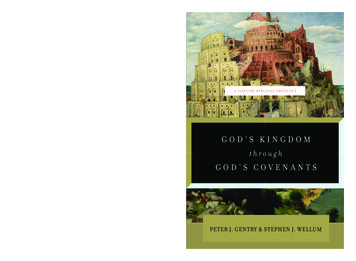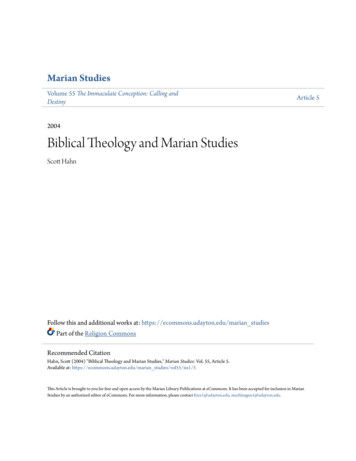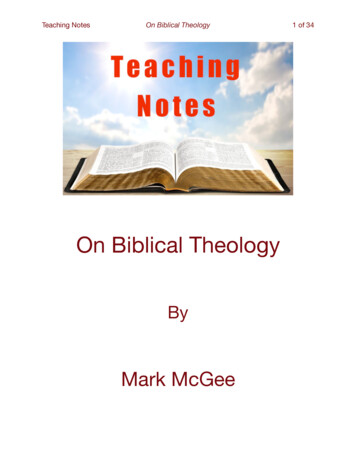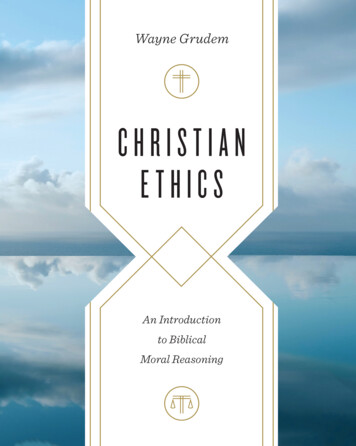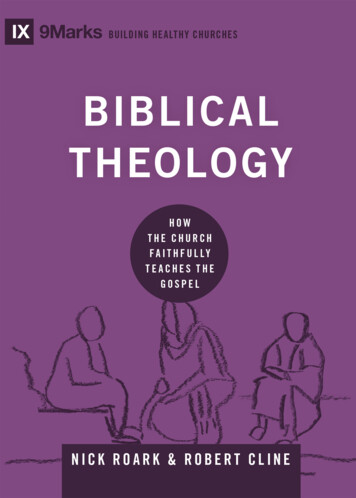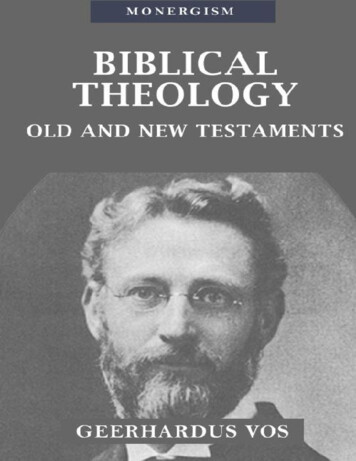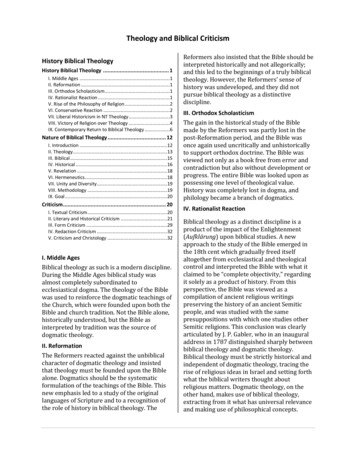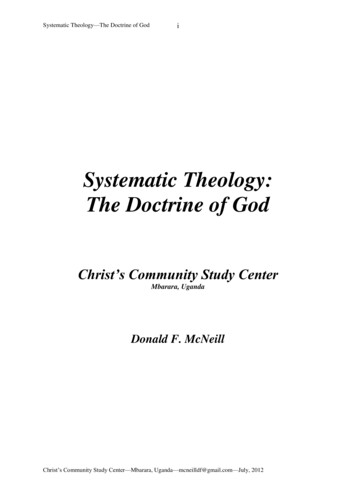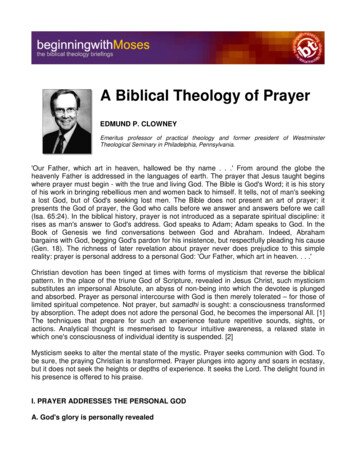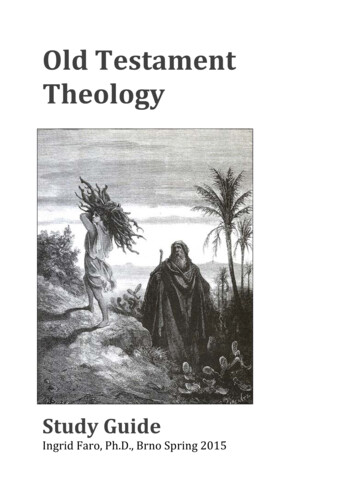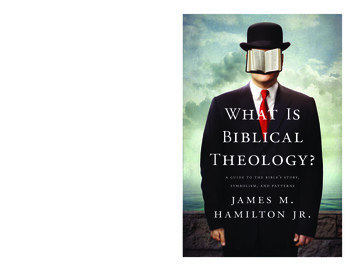
Transcription
How Do Y o u Re ad t he Bi bl e?“Want to know your Bible better? Jim Hamilton can help. What Is BiblicalTheology? is a manual for seeing how the many books of the Bible tell theone story about Jesus Christ. Hamilton will help you love Jesus more byunderstanding your Bible better.”C . J . M A H A N E Y , Senior Pastor, Sovereign Grace Church, Louisville, Kentucky“What Is Biblical Theology? confirms Hamilton’s reputation as a top-shelf thinker and awickedly good writer. He teaches readers to engage in biblical theology, allowing thebiblical story to shape and conform us.”W h at I s B i b l i c a l Th e o l o g y ?The Bible recounts a single story—one that began at creation,encompasses our lives today, and will continue until Christ’s returnand beyond. In What Is Biblical Theology?, Jim Hamilton introduces usto this narrative, helping us understand the worldview of the biblicalwriters so that we can read the Old and New Testaments as thoseauthors intended. Tracing the key patterns, symbols, and themes thatbind the Bible together, this book will help you understand Scripture’sunified message and find your place in the great story of redemption.B RU C E R I L E Y A S H F O R D , Provost, Dean of Faculty, and Associate Professorof Theology and Culture, Southeastern Baptist Theological SeminaryA N D R E W P E T E R S O N , singer/songwriter; author, The Wingfeather SagaHamilton“Theology is a word that comes with baggage. Most people, like me, find theirbrains shutting down a little at its mention. Hamilton shows us that if the Bibleis a story—and God is a storyteller—then biblical theology is less like math andmore like literature. This is a book I wish I could have read a long time ago.”W hat I sB iblicalT heology?a g u i d e t o t h e b i b l e ’s s t o r y,s y m b o l i s m , a n d pat t e r n sja mes m.h a m i lt o n j r .J A M E S M . H A M I LTO N J R . (PhD, The Southern BaptistTheological Seminary) is associate professor of biblical theology atthe Southern Baptist Theological Seminary. He is the author of God’sGlory in Salvation through Judgment, a commentary on Revelation, andnumerous articles and essays.U.S. 12.99CHRISTIAN THEOLOGY
“What Is Biblical Theology? confirms Jim Hamilton’s reputation as a top-shelfthinker and a wickedly good writer. This slim volume builds on the presupposition that the capacious biblical narrative—sixty-six books written bynumerous authors and including stories, poems, proverbs, letters, and apocalypses—possesses a deep inner unity. Its unity arises from its divine inspiration, and it is in fact the true story of the whole world. Hamilton teaches hisreaders to engage in biblical theology, allowing the biblical story to shape usand conform us to God’s will.”Bruce Riley Ashford, Provost, Dean of Faculty, andAssociate Professor of Theology and Culture, Southeastern BaptistTheological Seminary“Theology is a word that comes with baggage. Most people, like me, find theirbrains shutting down a little at its mention, mainly because it stirs up thesame sort of feelings as words like calculus and dentist appointment. But fromthe outset of this book James Hamilton assures us he’s not performing mentalacrobatics (though I’m sure he could if he wanted to). Rather, he’s showing usthat if the Bible is a story, and God is a storyteller, then biblical theology is lesslike math and more like literature; it’s less like a cold study of the chemicalproperties of paint and more like gazing at a Van Gogh. This is a book I wishI could have read a long time ago.”Andrew Peterson, singer/songwriter; author, The Wingfeather Saga“This short, accessible book shows how we can move away from making theBible all about us, reducing it to just another self-help book. Anyone whoreads What Is Biblical Theology? will begin to discover what the Bible is reallyabout and will have more ‘Now I get it!’ experiences as it equips readers totrace the thematic threads and story-line resolutions of the Bible from beginning to end.”Nancy Guthrie, author, Seeing Jesus in the Old Testament Bible studyseries“Disoriented Bible reading leads to disoriented living. Too often the Biblereader parachutes into a passage without understanding the immediate context or the overarching context of the entire Bible. Getting oriented to thewhole story of the Bible is the only way to right interpretation and right living. Gaining this whole-Bible interpretive perspective is the burden of biblicaltheology, and Jim Hamilton has given us an outstanding introduction to thisimportant yet neglected discipline. If the interpretive approach of Hamilton’sbook is applied, the reader will be able to better understand God’s Word, knowthe mind of Christ, and glorify God.”K. Erik Thoennes, Professor of Theology, Chair, Talbot School ofTheology, Biola University; Pastor, Grace Evangelical Free Church,La Mirada, California
“It is always a delight to read a book written by someone saturated in Scripture. This is one of those books.”Douglas Wilson, Senior Fellow of Theology, New St. Andrews College;Pastor, Christ Church, Moscow, Idaho“It is an exciting privilege to watch and benefit from ‘the coming of age’ of thediscipline of biblical theology in our generation. But in the explosion of literature we have needed a simple, brief, popular-level introduction—someone toprovide us with an aerial view of the forest before we begin making our wayamong all the trees. This is what Jim Hamilton has done for us here. What IsBiblical Theology? provides a very helpful jump start for beginning students,and students of all levels will be blessed in the reminder of the marvelouspatterns and themes that make Scripture such a glorious book.”Fred G. Zaspel, Pastor, Reformed Baptist Church, Franconia,Pennsylvania“I am truly amazed at all that Jim Hamilton has packed into this little volume.What Is Biblical Theology? is an engagingly written distillation of years of bothscholarly and devotional study of the Bible. The reader will find a succinct,clear, and compelling guide to the overarching story of Scripture. It will beat the top of my list of books to recommend for any who want to better understand the Bible, the world, and their place in God’s story. This is a gift forwhich I am exceedingly thankful.”Rob Lister, Associate Professor of Biblical and Theological Studies,Talbot School of Theology“Want to know your Bible better? Of course you do! Jim Hamilton can help.What Is Biblical Theology? is a manual for seeing how the many books of theBible tell the one story about Jesus Christ: who he is and what he has done. Dr.Hamilton will help you love Jesus more by understanding your Bible better.”C. J. Mahaney, Senior Pastor, Sovereign Grace Church, Louisville,Kentucky
W HAT I S B IBLICAL T HEOLOGY?
W H AT I SB IBLICALT HEOLOGY?A GUIDE TO THE BIBLE’S STORY,SYMBOLISM, AND PATTERNSJAMES M.H A M I LTON J R .W H E AT O N , I L L I N O I S
What Is Biblical Theology? A Guide to the Bible’s Story, Symbolism, and PatternsCopyright 2014 by James M. Hamilton Jr.Published by C rossway1300 Crescent StreetWheaton, Illinois 60187All rights reserved. No part of this publication may be reproduced, stored in aretrieval system, or transmitted in any form by any means, electronic, mechanical,photocopy, recording, or otherwise, without the prior permission of the publisher,except as provided for by USA copyright law.Cover design: Brandon HillCover image: Brandon Hill PhotosFirst printing 2014Printed in the United States of AmericaUnless otherwise indicated, Scripture quotations are from the ESV Bible (The HolyBible, English Standard Version ), copyright 2001 by Crossway. 2011 Text Edition.Used by permission. All rights reserved.Scripture quotations marked at are the author's translation.Trade paperback ISBN: 978-1-4335-3771-4PDF ISBN: 978-1-4335-3772-1Mobipocket ISBN: 978-1-4335-3773-8ePub ISBN: 978-1-4335-3774-5Library of Congress Cataloging-in-Publication DataHamilton, James M., 1974–What is biblical theology? : a guide to the Bible’s story,symbolism, and patterns / James M. Hamilton Jr.pages cmIncludes bibliographical references and index.ISBN 978-1-4335-3771-4 (tp)1. Bible—Theology. 2. Bible—Introductions. I. Title.BS543.H3355 2014230'.041—23 2013022763Crossway is a publishing ministry of Good News Publishers.VP1514241323122211211020 19 189 8 7 617516 15 144 3 2 1
For Evie Carolineour little girlMay it be granted you to clothe yourselfwith fine linen, bright and pure,for the wedding feast of the Lamb.(Rev. 19:7–8)
CONTENTS1A Better World Breaks Through 112What Is Biblical Theology? 15Part 1T HE BIBLE’S BIG STORY3The Narrative 274Plot: Conflict, Episodes, and Theme 355The Mystery 43Part 2T HE BIBLE’S SY MBOLIC UN I V ERSE6What Do Symbols Do? 617Imagery 678Typology 779Patterns 87Part 3T HE BIBLE’S LOV E STORY10A Song for the Lady in Waiting: The Bride of Christ and Biblical Theology9511The Church’s Identity in the Story 9912The Church’s Setting in the Story 10513The Church’s Plot Tension and Its Resolution 109
Epilogue 115For Further Reading 117Acknowledgments 119General Index 121Scripture Index 124
1A BETTER WOR LDBR E AKS THROUGHSitting uneasily in his chair, straining for breath, he tilted hishead toward his wife, nodded in the direction of my three sons,and said, “It’s good for them to be here.”Looking at me he continued, gasping out the words, “Wewanted to hide things like this. But it’s good for these boys tosee me dying. Death is real.”Later that night, his wife of more than fifty years becamea widow.Knowing that life was leaving his body, he saw rightthrough our medicated, sanitized, hedonistic culture. He couldignore death no longer, and he was convinced others shouldn’teither. There was no avoiding it, so he looked it in the face andaffirmed the goodness of the true story of the world. His approaching death was like a strong wind blowing away a fog offalsehood. A better understanding of the world broke through,as it had been doing since he was born again.What we think and how we live is largely determined bythe larger story in which we interpret our lives. Does your11
A Better World Breaks Throughstory enable you to look death in the face? Does your story giveyou a hope that goes beyond the grave?In the throes of death that night, my older brother in Christwas rejecting false stories of the world. He refused to live hislast moments informed by stories that would have people pretend death isn’t real or fear what lies beyond it.He wouldn’t have put it in these words, but he was affirming that it is good for children to see that the Bible’s story isreal. That’s what he meant when he said that it was good formy boys (ages six, three, and one at the time) to be there as hisbody fought through its failing moments.Will it take the nearness of your own death for you to rejectfalse stories in favor of reality?The world does have a true story. The Bible tells it. This bookis about the Bible’s big story, and it’s about how we becomepeople who live in that story. To do biblical theology is to thinkabout the whole story of the Bible. We want to understandthe organic development of the Bible’s teaching so that we areinterpreting particular parts of the story in light of the whole.As an acorn grows into an oak tree, Genesis 3:15 grows into thegood news of Jesus Christ.One of the primary aims of biblical theology is to understand and embrace the worldview of the biblical authors.In order to do this, we have to know the story they take forgranted, the connections they see between the events in thatstory, and the ways they read later parts of the story by the lightthat emanates from its earlier parts.The Bible has a narrative arc that begins at creation, risesover all that has been and will be, and lands at the end of allthings. The prophetic and poetic parts of the Bible provide in12
A Better World Breaks Throughterpretive commentary on the story, and the apocalypses unveilthe way things are and will be.The Bible’s big story, this overarching narrative, is also builtout of smaller stories. At the same time, the stories told in theOld Testament work together to set up a mystery resolved inChrist. Have you noticed the clues and hints that build to theclimactic revelation?Let’s think more about what biblical theology is, and thenwe’ll turn to the Bible’s big story, the symbols that summarizeand interpret the story, and the church’s place in it.13
2W H AT IS BIBLICA LTHEOLOGY?What is biblical theology? The phrase biblical theology is usedhere to refer to the interpretive perspective of the biblical authors.What is an “interpretive perspective”? It’s the frameworkof assumptions and presuppositions, associations and identifications, truths and symbols that are taken for granted as anauthor or speaker describes the world and the events that takeplace in it.What do the biblical authors use this perspective to interpret? First, the biblical authors have interpreted earlier Scripture, or in the case of the very first author on record (Moses),accounts of God’s words and deeds that were passed downto him.Second, they interpreted world history from creation toconsummation.And third, they interpreted the events and statements thatthey describe. Moses didn’t recount everything that Balaam saidand did in the instances presented in Numbers 22–24. Moses15
What Is Biblical Theology?selected what he wanted, arranged it with care, and presentedthe true story. The presentation of Balaam’s oracles that Mosesgives us in the book of Numbers is already an interpretationof them, and because I believe that Moses was inspired by theHoly Spirit, I hold that his interpretation makes his account ofthe Balaam oracles more true, not less. More true because theway Moses selected, arranged, and presented (i.e., interpreted)enables his audience to see more clearly how what Balaam saidand did fits into the true story of the world Moses tells in thePentateuch.To summarize, by the phrase biblical theology I mean the interpretive perspective reflected in the way the biblical authorshave presented their understanding of earlier Scripture, redemptive history, and the events they are describing, recounting, celebrating, or addressing in narratives, poems, proverbs,letters, and apocalypses.The previous sentence mentions various kinds of literature. The Bible is a book, and the men who wrote the sixtysix books that make up the Bible were engaged authors. Thatmeans we have to think about literature as we think aboutinterpreting the Bible. A short guide like this cannot exhaust these topics, but it can point to the path and offer somethoughts on how to stay on it. Our struggle is not againstflesh and blood. The study of biblical theology is like a questto become someone who can pull down strongholds withweapons mighty to God. For the quest to succeed we mustlearn to destroy arguments and lofty opinions raised againstthe knowledge of God, taking every thought captive to theobedience of Christ (2 Cor. 10:3–5). Welcome to this entrypoint on the path toward becoming a biblical theologian. With16
What Is Biblical Theology?the Lord’s help, the quest will take you into another world,the thought-world that is biblical theology.Here at the outset, let me say what biblical theology isnot—in my opinion, anyway. Some use the phrase biblical theology to mean something other than what I have hinted at above.Though we’re using the same phrase, we are coming at thesubject very differently. By biblical theology I do not mean “mytheology is more biblical than yours.” Nor do I refer to thatstick some biblicists keep at hand for whopping the unsuspecting systematic theologian who happens along (I once heard abiblical scholar declare, “Systematic theology is bad; biblicaltheology is good”).After the Enlightenment, certain ways of thinking aboutthe world fell out of fashion in the academy. Particularly, theBible’s. Heretics who styled themselves as courageous freethinkers chucked ideas that had prevailed among students ofthe Bible—biblical ideas about God’s sovereignty, the inspiration of Scripture, and the coherence and unity of the Bible’smessage.The story the Bible tells was rejected, and an alternativewas put in its place. The evidence for this alternative narrativeexists in the “scholarly” imagination. This alternative narrativehas its own time line, its own authors, and its own account ofwhat really went down: evolutionary development, competingideologies, the documentary hypothesis, and so forth. On thisreading, what the biblical texts say and the story the Bible tellsis mere propaganda.We have seen a world of responses to the influence of the(so-called) Enlightenment on biblical interpretation. One mightsay the responses have ranged from pole to pole.17
What Is Biblical Theology?At the South Pole the liberal response to the Enlightenmentwas to develop the academic discipline of biblical theology as away to sift the wheat from the chaff. Liberal academics soughtto discern which parts of the Bible’s theology remained relevant and which parts no longer were. Someone doing biblicaltheology in this way today might employ the method to arguethat the Bible endorses same-sex marriage and denounces theuse of fossil fuel. If the text as a whole is not authoritative, iteasily conforms to our agenda.From the North Pole, the conservative response to the Enlightenment at many points sought to use biblical theology toreassert the unity of the Bible. In an effort to establish common ground and persuade skeptics, conservatives (at least forthe sake of argument) conceded the chucked ideas. They weretrying to prove the Bible’s coherence to those who thoughtits unity had been shattered, so they resorted to methods andassumptions developed by and approved in the unbelievingguild. These methods and assumptions naturally placed limitson what the Bible could say.There is of course a vast terrain between these two poles,plenty of room for a variety of “biblical theological” programs.You might have a scholar trained at the South Pole (in a liberalenvironment) who critiques the excesses of “Antarctica” (theleft) from a biblical theological perspective. Conservatives getreally excited about these types. Or you might have a scholartrained on the North Pole denying the existence of true north.These scholars find themselves the darlings of post-evangelicalpublishers.The thing to note about these poles is that they’re on thesame planet. That is, the biblical theologians going about their18
What Is Biblical Theology?work these ways, whether starting from North Pole or South,are all living in the same world, breathing the same air, sharing the same assumptions. But what if biblical theology is abridge going somewhere else? What if it’s a way to get out ofone world into another?This book is not trying to be a compass you can use to gonorth or south. It’s trying to help you find treasure in the trash.The way of thinking modeled and taught by the Bible’s authorswas scrapped, but when we pull these ideas out of the garbage,we find them worth more than the million-dollar painting TresPersonajes that Elizabeth Gibson found in the trash on the streetin New York City.Our aim is to trace out the contours of the network ofassumptions reflected in the writings of the biblical authors.If we can see what the biblical authors assumed about story,symbol, and church, we will glimpse the world as they sawit. To catch a glimpse of the world as they saw it is to see thereal world.I hasten to add that the Holy Spirit inspired the biblicalauthors. That gave them a level of certainty about their interpretive conclusions that we cannot have about ours because theHoly Spirit does not inspire us and guarantee our inerrancy. Ifhe did, our books would be added to the canon of Scripture,which is not happening. Still, we’re called to follow the apostlesas they followed Christ (cf. 1 Cor. 11:1), and part of doing thatmeans learning to interpret Scripture, redemptive history, andthe events that happen to us the way the biblical authors did,even if absolute certainty eludes us.What I’m suggesting is that the Bible teaches Christianshow the Bible should be read. Studying biblical theology is19
What Is Biblical Theology?the best way to learn from the Bible how to read the Bible as aChristian should. By the same token, studying the Bible is thebest way to learn biblical theology.How should a follower of Jesus read the Bible? The wayJesus did. Jesus of Nazareth did not write any of the booksin the Bible, but he taught the writers of the New Testamenthow to interpret earlier Scripture, redemptive history, andthe events they were narrating and addressing. On the humanlevel, Jesus learned the interpretive perspective he taught to hisdisciples from Moses and the Prophets.So I’m arguing that the biblical authors operated froma shared interpretive perspective. They inhabited the samethought-world, breathed its air, and shared its assumptions.The world they lived in wasn’t Darwin’s. In their world wemight find things for which we have no analogy and of whichwe have no experience. There is no analogy for the God ofthe Bible. He stands alone. We will experience him only if hereveals himself. In the Bible he has done just that. How dowe come to know him? From his revelation of himself, fromlearning to read the Bible from the Bible itself. To learn toread the Bible is to learn to understand this world from theperspective of the biblical authors, which is to learn a divinelyinspired perspective.Moses learned and developed the ability to see the worldthis way from the accounts of God’s words and deeds that hereceived, from his contemplation of what God had done in hisown life, and from the inspiration of the Spirit of God. Thebiblical authors who followed Moses in the Old Testament,whether historians, prophets, psalmists, or sages, learned theinterpretive perspective that Moses modeled for them and had20
What Is Biblical Theology?it confirmed by other Scripture available to them. Jesus thenlearned to read the Bible, history, and life from Moses andthe Prophets, and he taught this perspective to his followers(Luke 24). What we find in the New Testament, then, is Christtaught, Spirit-inspired biblical interpretation.The biblical authors model a perspective for interpretingthe Bible, history, and current events. Should we adopt thatperspective today? Absolutely. Why? I’m convinced that thebiblical authors were inspired by the Holy Spirit, that Godguided them to the truth by his Spirit, and that, therefore,they got it right.I am confident that the apostles got it right and thatthose who would follow Jesus (Christians!) should followthe apostles as they followed Jesus (cf. 1 Cor. 11:1). I amalso confident that as we try to follow Jesus by followingthe apostles, we will make mistakes. The history of interpretation is full of mistakes. We see through a glass darkly(1 Cor. 13:12). But again, the fact that the Spirit is not ensuring the inerrancy of our conclusions does not mean weshould adopt an un- or a-biblical perspective when readingthe Bible, thinking about redemptive history, or trying tounderstand our own lives. It does mean that we should holdour conclusions with humility, fight that manxome foe, andallow the Bible to correct us.At this point I hope you want more—more of the Bible,mainly, but also more information on how to understand andembrace the network of assumptions modeled by the biblical authors. As mentioned above, a short book like this is alittle like standing by that path that leads to the bridge thatleads to a different world. The Jabberwock and the frumious21
What Is Biblical Theology?Bandersnatch prowl the path, and you can take your chancesstarting from this point. I’m writing this book because I’m convinced that the world to which this path leads is worth anyrisk to reach.There are more detailed descriptions of this path, evenguided tours of it, but for those with an opportunity and anadventurous spirit, here’s what this book has for you. The restof it falls into three parts: the first sets out the Bible’s big story,the second looks at the way the biblical authors use symbolsto summarize and interpret that story, and the third considersthe part the church plays in that story.So the three parts of this book can be put into three words:story, symbol, and church. There’s obviously more that could besaid about biblical theology, but these are the three things aboutthe path to the bridge into another world we’ll focus on here:the overarching metanarrative that is the Bible’s big story, theway the biblical authors use key symbols to summarize andinterpret that story, and the place of the church in it.If biblical theology is a way to get into another world, theworld inhabited by the biblical authors, you have a right tounderstand my intentions. My hope is that you cross the bridgeinto their thought-world and never come back. I hope youwill breathe the air of the Bible’s world, recognize it as the realNarnia, and never want to leave.If this happens, you will have come to inhabit the Bible’sstory. My prayer is that its symbols and patterns will shape theway you view the world, and that your understanding of thechurch’s place in story and symbol will make you know theriches of God’s inheritance in the saints (Eph. 1:18), the greatpower “he worked in Christ when he raised him from the22
What Is Biblical Theology?dead” (1:20), and the glory he displays in the church and inChrist Jesus forever (Eph. 3:21).In brief, I hope that you will adopt the perspective of thebiblical authors and that you will read the world from theBible’s perspective, rather than reading the Bible from theworld’s.23
Part 1THE BIBLE’SBIG STORY
3THE NA R R ATI V EWhat’s a narrative made of ? Narratives have a setting, characterization, and plot. Plots are built out of episodes and conflict,and if successful they communicate themes.SET TINGThe Bible is set in the world as we know it. Most of its storyhappens on the three bodies of land around the MediterraneanSea, but the story is about the whole world. The Bible presentsan interpretation of its own setting that gets at the meaningand purpose of this world God created.Shakespeare showed his genius in a theater named theGlobe. The place was aptly named, as Shakespeare held the mirror up to nature and depicted the world as it is. The real worldwhere God shows his genius is the archetype of the theaterwhere Shakespeare showed his. God built this stage to showhis craft. The world is a theater for the display of God’s glory.God built the set (created the world) so there would bea place where he is known, served, worshiped, and present.Places where gods are known, served, worshiped, and present27
T he Bible’s Big Storyare called temples. God built the earth as his temple, and in ithe put his image and likeness. The realm that God has createdis a cosmic temple; the image God put in the temple to represent himself is mankind. Everything God made was good, butthe characters in the drama rebelled against God and defiledhis temple. In response to the sin of Adam, God subjected creation to bondage, offering hope, however, that there would bea restoration.Don’t miss the connections between the setting and thecharacters. God made and owns the setting. It’s his. It’s for him.It’s about him.The worldwide setting of the Bible’s story is presented asGod’s cosmic temple. The tabernacle and later the temple Godgave to Israel were small-scale versions of the cosmos, microcosms (Ps. 78:69). This understanding of the story’s settinghas implications for the story’s characters: that the world is acosmic temple means that it’s a place in which God is known,served, present, and worshiped. The human characters in thetemple are the real thing imitated by idolaters who build temples to false gods and then put wood or stone “images” of thosegods in those temples. In the real story, the image of God inGod’s temple is a living, breathing, worshiping human being.Then there are the enemies: the serpent and his seed are tryingto usurp God, but all they accomplish is the (temporary) defilement of God’s temple.As the setting of the story is related to the characters inthe story, so also the setting is key to the plot. The plot beginswith the making of the cosmic temple, which is defiled by sin.Once it is defiled, however, God makes statements that hintat restoration. Eventually God gives to the nation of Israel a28
The Narrativesmall-scale version of the setting, a microcosm, when he givesthem first the tabernacle and later the temple. The judgmentsvisited on the microcosms (when tabernacle and temple aredestroyed) point forward to the judgment that God will bringon the macrocosm (the world), and then God will bring abouta new and better cosmic temple, a new heaven and earth. Atthis restoration God will make things better than they were atthe beginning.CH A R ACTERSNo offense, but you aren’t the main character in the big storyof the world. One of the best things that can happen to us isdiscovering our role in the real story of the world.The triune God is the protagonist of this cosmic drama,with Satan as the (infinitely outmatched) antagonist, and thereare other heavenly beings involved in the story. God and Satanare locked in conflict, each seeking the allegiance of humansmade in God’s image. Protagonist and antagonist are contending for dominion over the world God made. It doesn’t take agenius to predict victory for the Creator, but it takes the powerof the Spirit to side with him.Humans are either seed of the woman or seed of the serpent. The Hebrew word rendered “seed” or “offspring” or (lessfelicitously) “descendants” in English can refer to one “seed”or to a handful of “seed.” There are individual (Gal. 3:16; Rev.12:5) and collective (Rom. 16:20; Rev. 12:17) manifestations ofthe seed of the woman and the seed of the serpent in the Bible.There
What is biblical theology? : a guide to the Bible’s story, symbolism, and patterns / James M. Hamilton Jr. pages cm Includes bibliographical references and index. ISBN 978-1-4335-3771-4 (tp) 1. Bible—Theology. 2. Bible—Introductions. I. Title. BS543.H3355 2014 230'.041—23 2013022763 Crossway is a publishing ministry of Good News Publishers.
